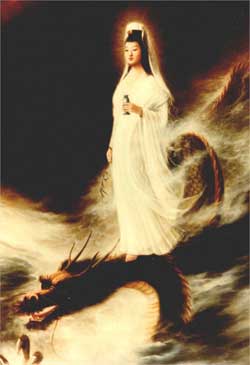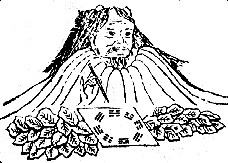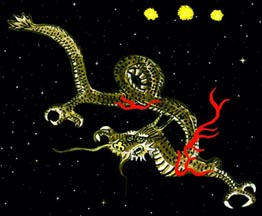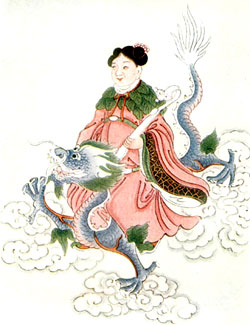The Birth of Issinryu
The Dream • Star Gazer • A Prosperous DayTHE NAMING OF ISSHIN-RYU
January 15, 1956 / By Arcenio J. Advincula)
"In the beginning there was the one."
~ Lao Tsu, Curator of the Royal Library in Loyang, the keeper of the books
Historical Note: On March 7, 1959, I attended a demonstration put on by Shimabuku Tatsuo Sensei and the Honbo dojo to commemorate the 3rd year anniversary of the naming of Isshin-ryu karate. A Invitation letter dated February 26, 1959 was sent out announcing this event. In part, the letter announced that this was part of the Ryukyuan-American Friendship activities and a commemoration program for the 3rd anniversary of the birth of Isshin-ryu.
At a later date, I asked Shimabuku Sensei if this was the birthday of Isshin-ryu. Shimabuku said there was no actual birthday for Isshin-ryu, explaining it took years to develop. That he was always experimenting. January 15, 1956 was the day he announced the naming of his style. In an interview with Shimabuku's second son Shinsho, he said the same. "My father was always experimenting. Trying new techniques. He did this all his life. He was an innovator. There is no birthday for Isshin-ryu." While both Tatsuo and Ciso both have said there is no actual birthday for Isshin-ryu, I have no problem if they want to use that day as the birth of Isshin-ryu. But I will always explain that Tatsuo said that Isshin-ryu was not born in a single day, I will honor the date of the naming of isshin-ryu as a historical day, but most importantly honor the birth of Tatsuo, as the day Isshin-ryu was born. For without Shimabuku Tatsuo, there would be no Isshin-ryyu karate. Isshin-ryu is heart and Shimabuku was the heart and soul of Isshin-ryu.

Shimabuku Tatsuo, was born in Chan (Kyan) village on Meiji 41 (September 19, 1908). When Shimabuku was around 12 years old, he began studying karate from his uncle Ganiku Shinko who had studied Shaolin (Shorinji) kenpo in China from Kushi (Koshi Jp.) and Mushi (Moshi Jp.).Ganiku was a school principle at Isshikawa, but lived in Agena. Shimabuku lived in Chan village which was only a few blocks from where Ganiku lived. From Ganiku, Shimabuku also learned how to be a shimuchi (sumuchi), or fortune teller. Ganiku taught Shimabuku all he could aboutkarate but told Shimabuku to study with Kyan Chotoku who at the time was living and teaching karate in Yomitan and also in Kadena. His home and dojo was located next to the Hija River stone bridge across from the Kadena side. Kyan built his house on his wifes property. Kyan's wife was from Kadena and owned a lot of property in the area. Kyan was from Shuri and after marrying his wife moved to Kadena area to be with here. While Kyan often went back to Shuri, Kadena and Yomitan was now his home. So the young Shimabuku who had just married his wife Uto in 1932, also began training with Kyan Chotoku the same year.
Tatsuo would also study Goju-ryu karate from Miyagi Chojun in Naha, and Motobu Choki also in Naha. After WW2, in 1946 he opened his first dojo in Konbo Village. Later he opened the Minoro dojo in Koza City. He returned to a location near his home in Chan Village and continued to teach first in Tairgawa Village and then Chan at his home.
Shimabuku, up to this time, had taught mainly, Shuri-te. He called what he was teaching Chanmigwa-te after his first formal teacher Kyan Chotoku who's nickname was Chanmigwa. Chanmigwa means "Small eye Chan." "Chan" in Uchinaguchi (Okinawa dialect) is "Kyan." In "mi" in Uchinaguchi means "eye", and the suffix "Gwa" or "Guwa" mean's "small." So Chanmigwa means "Small-eye-Chan (Kyan)."
In 1955, Shimabuku had a vision while listening to his radio in his home in Chan Village. He was dozing off and daydreaming when a goddess riding a dragon flew and circled him. The goddess was Ryuzu Kannon, the Buddhist goddess of Mercy and compassion. The goddess told him to create his own style of karate telling him that he had enough knowledge and experience along with his own ideas of karate. The goddess also told Shimabuku to first make a image of her that incorporated all of his thoughts about his new style. According to Shinsho (Ciso), Shimabuku's second son, his father meditated on and off for three to four months on what the image of the goddess should be. He wanted to create a image of her that would incorporate the past and present of his new system.
Photo: Ryuzu or Ryuto (Dragon-head) Kannon (Buddhist goddess of mercy) Ciso demonstrating how his father meditated. From Ganiku he learned to be a Sumuchi2 (Shimuchi), a fortuneteller that uses ancient Chinese and Japanese books such as the I Ching), Funshii (Feng Shui), Astrology, Almanac and other books used in fortunetelling. Sumuchi in Uchinaguchi (Okinawa dialect) literally means "book" and a fortuneteller is called a Sumuchi. The primary book used by the Sumuchi is the I Ching. Funshii in Uchinaguchi is (Feng Shui) the ancient Chinese practice of placement and arrangement of space in relation to patterns of yin and yang and the flow of energy (ki) to achieve balance and harmony with the environment. Shimabuku studied two modes of Shurite from Kyan and Motobu, and also studied Nahate from the founder of Goju-ryu Miyagi. Shimabuku learned the Kenpo gokui from Miyagi Sensei and later for a time gave a silk copy of it to many of his students when they made black belt. Shimabuku called them the Kenpo gokui which means "Essential points of kenpo or karate." So the image of the goddess must represent both Shurite and Nahate. His new style should also represent the better of these two modes along with his own innovations. From Kyan Sensei, he had also learned basic sai techniques and one kobudo bo kata, Tokumine no kun. Shimabuku Sensei told me that the image within the Isshin-ryu no Megami represents Shorin-ryu and Goju-ryu and also kobudo which make Isshin-ryu. He said he took the kata naihanchi from Shorin-ryu and sanchin from Goju-ryu stating traditional Shorin-ryu has no sanchin kata, and Goju-ryu has no naihanchi kata. He then explained the symbol had the Kenpo gokui embedded in it as all these things influenced his new style. Shimabuku said he had been experimenting long before he named his style and we can see in a photograph taken in Tairagawa in the late 1940's that he already used the fist with the thumb placed on top instead of along the side of the fist which is the traditional method. The unique techniques he was to introduce to his new system is the way he made his fist as mentioned above along with blocking using two bones reinforced with muscle. One of the most important aspect was how to deliver the punch and so the vertical non-rotating punch was to be the primary punch of his new style. He was about to change from the traditional twist rotating type punch used in all Okinawan systems up to that time. While the punch was used by other Okinawan karate practitioners, the punch was used sparingly for special situations. Kyan Chotoku was known to have used the punch against taller opponents. In an interview with Nakazato Joen who studied with Kyan at the Agricultural School in Kadena, Joen stated Kyan used the punch against a taller opponent. Nakazato when asked if Shimabuku learned the punch from Kyan Sensei, Nakazato stated no. This was all Shimabuku's idea. Nakazato said Kyan told all his students that it was not necessary to use the standing punch that he used it only in select circumstance against a taller opponent. Shimabuku was about to be be the first Okinawan to use the vertical punch as the major punching technique in his new style. Shimabuku learned Feng shui, the art of placement from Ganiku and studied the stars. He knew about the Dragon constellation "Tatsu"' which represent the Azure (blue-green) dragon of the East. Within the constellation were three stars on line (***) which represented the heart of the dragon. So Shimabuku would name his new style Isshin-ryu and the three stars (***) in the position of the kanji one (---) will have dual meaning. The threes stars on line will represent "Isshin" meaning "one heart" or "wholehearted." Shimabuku would also take the name "tatsu" from the Dragon constellation Tatsu, and add the kanji "O" to Tatsuo, meaning "Dragon man." As is custom, this was now his professional name and it all came from Feng shui and knowing the stars. The three stars on line both stand for the heart in the Chinese constellation Azure dragon and the constellation Scorpio. The 3 stars on line have a dual meaning. It stands for "heart" and also (***) stand's for the kanji (---) "one". The dragon "Tatsu" also pronounced "ryu" also stands for the "ryu" in Isshin-ryu I asked Ciso if his father ever studied the stars, "My father memorized the stars" Ciso replied. "It is part of Funshii (Feng shui)' he said. Now all this idea of creating a new style was because of the inspiration created by Ryuzu Kannon riding a dragon. So he would combined the goddess with the dragon she road as one just as he used the three stars on line to represent "one heart." The goddess Ryuzu Kannon with the dragon creating a Ryujin, Dragon-human-deity. So Shimabuku looked at change in a positive light and with guidance from the I Ching and Feng shui, Heaven, Earth and Man will all come together within his universe. The metamorphosis of the Buddhist Goddess of Mercy Kannon, and the Azure Dragon into a Ryujin (Dragon person) will end into the Isshin-ryu no Megami (Goddess of Isshin-ryu). The metamorphosis of naihanchi kata (mother) and sanchin kata (Father) will give birth to the offspring Isshin-ryu). The metamorphosis of heart of the dragon (three stars) and one (---) will become Isshin (One heart). The metamorphosis of the constellation Tatsu (Azure dragon) and the kanji for "man/husband" will become Tatsuo, the Dragon-man of Isshin-ryu. Now there is often speculation on where Shimabuku had the inspiration to combine the goddess kannon with the dragon. In Chinese and Japanese mythology there are numerous mythical beings and creatures. The first mythical animal that comes to mind is the dragon and phoenix. As for inspiration to combine the Megami and dragon together all we have to do is see Fu Shi the mythical emperor who created the I Ching's Eight Trigrams. Fu Shi and his wife Nu Gua were both half dragon and serpent. So inspiration for combining the goddess with the dragon may have been Fu Shi the inventor of pagua the eight trigrams that underlie the I Ching. And we all know that Tatsuo used the I Ching. Fu Shi, creator of the Eight Trigrams found in The I Ching Eight trigrams.
Eight Trigrams And the I Ching is the reason all these changes came from. All this knowledge Shimabuku learned from his first teacher Ganiku who taught him to be a Sumuchi. Indeed the universe is in a constant state of flux and changing and to avoid change one would miss opportunities to develop oneself and all things within their own world. It took thought and understanding and he understood that one must strike when the opportunity presented itself and the vision of the goddess Ryuzu Kannon gave him that opportunity. Shimabuku now had a chance to make his own style and make his own rules. Whatever he created must be balanced. He knew to balance a scale; one must adjust the weight moving it back and forth adjusting until it became balanced, as well as, in the middle. His style would follow the mean. The goddess Ryuzu Kannon will be the main theme of his symbol for she was the main purpose for creating his new style. She was a dragon goddess and dragons have power. Shimabuku knew the powers of the dragon, for the Azure Dragon of the East is one of the Four Symbols of the Chinese constellations, representing spring, the element Wood. Dragons in Oriental folklore are believed to be the most powerful and in Feng shui, are the most important symbol. They are the Supreme Being among all creatures and are the symbol of life, growth, and success. Dragons ward off evil spirits and give protection to all. The Dragon brings five blessings: harmony, virtue, riches, fulfillment and longevity. And was it not Ryuzu Kannon who came to him in his daydream. So Shimabuku named his new style Isshin-ryu from the heart of Seiryu the Azure Dragon constellation and also took his name from it. The goddess will be named the Isshin-ryu no Megami (Goddess of Isshin-ryu) because she was the inspiration for creating the style. The Azure dragon will be placed above the Megami along with the three stars. Dragon in Japanese can be pronounced "tatsu" or "ryu." The word "ryu" is a homophone, A word having the same sound as another word but differing from it in meaning, origin and sometimes spelling. So in the picture, the "ryu" in Isshin-ryu has two meanings. First it represents and symbolizes Tatsu, and secondly, it represents "ryu" for style. So the three stars (***) on line represents the kanji one (---) and the dragon tatsu pronounced "ryu?h represent the word Isshin-ryu. Seiryu (Azure dragon) Shimabuku now had an idea of what the image of the goddess riding the dragon would look like so he told his trusted friend and student Kaneshi about his daydream and his vision of the goddess riding a dragon. To understand the rest of the beginning of Isshin-ryu we have to make one thing clear. The actual name of Kannon riding a dragon is Ryuzu or Ryuto Kannon. Ryuzu is made of two kanji. The first kanji "ryu" means "dragon" and the second kanji "zu or "to" means "head." In Japanese Buddhism, traditional there are 33 different manifestation of the Goddess of mercy, Kannon. In reality, there are many more depictions of Kannon in both male and female form. While the name Ryuzu meaning Dragon head is the name of the Kannon with a dragon, it does not mean Kannon the goddess has a head of a dragon. Often we see in Chinese art a deity such as a Goddess or God riding a dragon or other mystical anima. Kaneshi Eiko Sensei began his training from Shimabuku Tatsuo in Minoro dojo, Koza City in 1947. He was a Shinpu or Shinto priest of the "Seicho No Le (House of growth) branch." Kaneshi after hearing of Shimabuku's daydream had his uncle paint the first picture of the Isshin-ryu no Megami according to Shimabuku's description he had given him. Kaneshi's uncle was also a student of Tatsuo and painted the goddess with the head of a dragon. When Shimabuku Sensei saw the painting, he laughed and told Kaneshi the ll though the goddess is Ryuzu or Ryuto meaning "Dragon head," the goddess should not have a head of a dragon and that was only the name of the deity. Shimabuku furthur explained, that the goddess should be half human with a body of a dragon. Shimabuku then gave Kaneshi the nickname Ryuto meaning (Dragon man), after the "Azure Dragon of the East." As we can see, Shimabuku gave Kaneshi a name similar to his own name. Tatsuo means "Dragon man or husband, Ryuto means "Dragon man or person". The first picture of the Isshin-ryu no Megami with the head of a dragon was incorrect. Shimabuku had completed making a image of the goddess Ryuzu Kannon. It was now the time to announce the naming of his new style of karate to his students and make the changes become reality. After careful thought, on January 15, 1956, Shimabuku called a meeting at his home in Chan Village which was also his dojo. At this meeting, he publicly announced to his students that he was renaming the style he was teaching and also making changes for his new style. Ciso explains that there were about twenty at the meeting with two or three Americans present. One interesting fact is none of the known Americans have ever mentions this historical event so it is very evident, those who have claimed to have started Isshin-ryu before it was named have embellished their credentials. And yes, there are some Americans who claim to have started in Isshin-ryu in 1955 before it was even named. This may be the reason so many claim Isshin-ryu karate was named on January 15, 1954. Oshogatsu (New Year) follows the Gregorian calendar used today and starts Ganjitsu or New Years Day, January 1 each year. Soguwachiguwa (Okinawan dialect) Koshogatsu (Japanese), literally means "Small New Year," follows the lunar calendar. It begins on the first full moon of the New Year which generally falls around the fifteenth of January. It is still widely observed in rural areas in Okinawa and Japan, where Toshigami ( Kami of the incoming year) or gods related to agriculture. Toshigami or Toshitokujin are also called Shogatsu-sama (lit., "Honorable New Year"). The name Toshitokujin has its origins in Chinese Yin-Yang divination (Jp. Onmyodo ''Way of Yin and Yang), and refers to a goddess with dominion over auspicious directions for the current year. It is believed by those who worship and honor the New Year's kami that the Toshigami will ensure an abundant harvest. Shimabuku Sensei was both a farmer and Sumuchi (Fortuneteller) who used the I Ching (Book of Changes) and the I Ching is based on the changes of the Sun and Moon which are a metaphor for Yin and Yang. It would be fitting that Shimabuku would announce the name his new style of karate on Soguwachiguwa (Small New Year's) which in modern times falls on January 15. Most likely, as a farmer and Sumuchi, Shimabuku would have used the I Ching to pick a auspicious date and as custom, what better date then Small New Year to plant new seed to bear new crops. In this case, the seed planted, was Isshin-ryu. As stated above Toshigami, originally an agricultural deity (God/Goddess of the seasons and the vegetation cycle) became a New Year deity, but to Shimabuku, Toshigami was not just a deity of the incoming new year, Toshigami was still an agricultural deity and was greeted to ensure the protection of the gokoku or five grains, rice, wheat, barley, beans, and millet, which Okinawan farmers needed grow to survive. The old Okinawa tradition, Soguwachiguwa or Small New Year's, always follows the lunar calendar and is therefore celebrated on the first full moon of the year, around the 15th of January. While Shimabuku was not planting agricultural seed, he was planting a new style with new ideas, called Isshin-ryu. As Shimabuku Tatsuo, the reader of the books said, "All things begin with one," and as we all know, on January 15, 1956, he planted one seed. BibliographyTHE DREAM


STAR GAISER


![]()
![]()
![]()
![]()
![]()
![]()
![]()
![]()


In attendance at this meeting, were Tatsuo's second son Shinsho (Ciso) and Kaneshi Eiko. Kaneshi was one of Tatsuo's first students and had also studied with Nagamine Shoshin of Matsubayashi-ryu before he came to Shimabuku in 1947. Shimabuku told his students he was now changing from Chanmigwa-te to Isshin-ryu karate. He also told them about the fist change, blocking change and punching change. Kaneshi, after hearing Shimabuku name his new style Isshin-ryu, asked him, "Why such a funny name!" Shimabuku answered, "Because all things begin with one."

A PROSPEROUS DAY
• Kaneshi Eiko (1984) Personal Communication
• Kaneshiro Kenji (1984) Personal Communication
• Maekawa (Maj. Mike) (1981&1995) Personal Communication
• Nakazato Joen Founder Shorinji-ryu Personal Communication
• Shigema Genyu (1984) Personal Communication
• Shimabuku Shinsho (Personal Communication 1958-2004) .
• Shimabuku Tatsuo Personal instruction (1958-60, 61-64, 69-70, 75)
• Third Anniversary of Isshin-ryu Karate announcement February 26, 1959
• Tome Yushin (1981-1995) Personal Communication
• Tokumine Sheisho (1996) Personal Communication